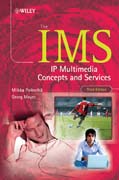
The IMS builds on the success of the first two editions to provide comprehensive coverage of IMS: its concepts, architecture, protocols and functionalities. It has been completely revised to include a number of new chapters which replace superseded topics, while remaining chapters are updated. In part 1, more information on TISPAN, I-WLAN, Cable is included and chapters are added on subjects such as IMS transit, Communication Continuity (VCC / PS-2-PS Handover) and IMS interconnection. Part 2 contains two new chapters on Multimedia Telephony and SMS over IMS while part 3 is completely updated with chapters added on Interworking and Voice Call Continuity. Part IV Protocols, of the previous edition will be added to a new companion website. INDICE: Foreword. Preface. Acknowledgements. List of Figures. List of Tables. PART I IMS ARCHITECTURE AND CONCEPTS. 1 Introduction. 1.1 What is the Internet Protocol Multimedia Subsystem (IMS)? 1.2 Fixed and Mobile Convergence. 1.3 Example of IMS Services. 1.4 Where did it come from? 1.5 Why a SIP Solution Based on 3GPP Standards? 2 IP Multimedia Subsystem Architecture. 2.1 Architectural Requirements. 2.2 Description of IMS-related Entities and Functionalities. 2.3 IMS Reference Points. 3 IMS Concepts. 3.1 Overview. 3.2 Registration. 3.3 Mechanism to Register Multiple User Identities at a Go. 3.4 Session Initiation. 3.5 Identification. 3.6 IP Multimedia Services Identity Module (ISIM). 3.7Sharing a Single User Identity between Multiple Devices. 3.8 Discovering the IMS Entry Point. 3.9 S-CSCF Assignment. 3.10 Mechanism for Controlling Bearer Traffic. 3.11 Charging. 3.12 User Profile. 3.13 Service Provision. 3.14 Connectivity between Traditional CS Users and IMS Users. 3.15 IMS Transit. 3.16 Support for Local Dialling Plans. 3.17 IMS Emergency Sessions. 3.18 SIP Compression. 3.19 Combination of CS and IMS Services Combinational Services. 3.20 Voice Call Continuity. 3.21 Security Services in the IMS. 3.22 Interworking between IPv4 and IPv6 in the IMS. PART II IMS SERVICES. 4 Presence. 4.1 Who will use the Presence Service? 4.2 Presence-Enhanced Services. 4.3 Presence Contributingto Business. 4.4 What is Presence? 4.5 Presence Service in IMS. 4.6 Publishing Presence. 4.7 Subscribing Presence. 4.8 Watcher Information. 4.9 Setting Presence Authorization. 5 Group Management. 5.1 Group Managements Contribution toBusiness. 5.2 What is Group Management? 5.3 What is XML Configuration Access Protocol? 5.4 What is Common Policy? 5.5 Resource List. 5.6 XCAP Usage for Resource Lists. 5.7 Open Mobile Alliance Solution for Group Management. 5.8 Multimedia Telephony and Service Management. 6 Push to Talk Over Cellular. 6.1 PoC Architecture. 6.2 PoC Features. 6.3 User Plane. 6.4 PoC Service Settings. 7 Messaging. 7.1 Overview of IMS Messaging. 7.2 Immediate Messaging. 7.3 Session-Based Messaging. 7.4 Messaging Interworking. 7.5 Instant Messaging by Open Mobile Alliance. 8 Conferencing. 8.1 IMS Conferencing Architecture and Principles.8.2 IMS Conferencing Procedures. 9 Multimedia Telephony. 9.1 Introduction. 9.2 Multimedia Telephony Communication. 9.3 Supplementary Services. PART III DETAILED PROCEDURES. 10 Introduction to Detailed Procedures. 10.1 The Example Scenario. 10.2 Base Standards. 11 An Example of IMS Registration. 11.1 Overview. 11.2 Initial Parameters and IMS Management Object. 11.3 Signalling PDP ContextEstablishment. 11.4 P-CSCF Discovery. 11.5 SIP Registration and Registration Routing Aspects. 11.6 Authentication. 11.7 Access Security IPsec SAs. 11.8 SIPSecurity Mechanism Agreement. 11.9 IMS Communication Service Identification and other Callee Capabilities. 11.10 Compression Negotiation. 11.11 Access and Location Information. 11.12 Charging-Related Information During Registration. 11.13 User Identities. 11.14 Re-Registration and Re-Authentication. 11.15 De-Registration. 11.16 GPRS-IMS-Bundled Authentication (GIBA). 12 An Example IMS Multimedia Telephony Session. 12.1 Overview. 12.2 Caller and Callee Identities.12.3 Routing. 12.4 Compression Negotiation. 12.5 Media Negotiation. 12.6 Resource Reservation. 12.7 Charging-Related Procedures During Session Establishment for Sessions. 12.8 Release of a Session. 12.9 Alternative IMS Session Establishment Procedures. 12.10 Routing of GRUUs. 12.11 Routing of PSIs. 12.12 A Short Introduction to GPRS. 13 An example IMS Voice Call Continuity Procedures. 13.1 Overview. 13.2 Configuring the Clients with Communication Continuity Configuration Parameters. 13.3 Setting up the Initial Call and Call Anchoring. 13.4Domain Transfer: CS to IMS. 13.5 Theresa adds Video to the Call. 13.6 Domain Transfer: IMS to CS. 13.7 Related Standards. References. List of Abbreviations. Index.
- ISBN: 978-0-470-72196-4
- Editorial: John Wiley & Sons
- Encuadernacion: Cartoné
- Páginas: 560
- Fecha Publicación: 23/01/2009
- Nº Volúmenes: 1
- Idioma: Inglés
